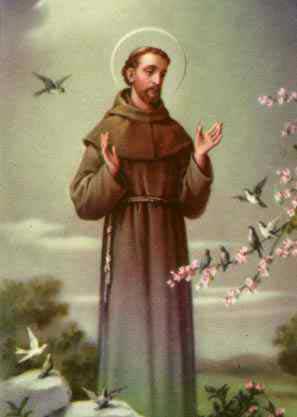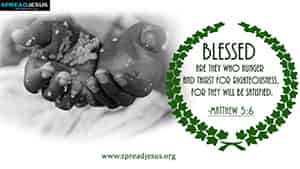Saint Francis of Assisi Catholic Saint
Catholic Saints 28-12-2023, 19:38

Saint Francis of Assisi
Catholic Saint
st.Francis of Assisi-Stigmatist, considered to be the founder of all Franciscan orders
Feast Day : October 4
Patronage: animals; birds; Catholic action; ecologists; merchants; zoos Name meaning: Free one
Also known as: Little Poor Man, Il Poverello
Francis of Assisi was born in either 1181 or 1182 in the town of Assisi in Umbria, Italy, at a time when his wealthy father, Pietro Bernardone, was away. His mother, Pica, baptized him as Giovanni after John the Baptist. His father had the name changed to Francesco, “the Frenchman,” in honor of the time he spent in France conducting his successful silk cloth trade. Francis spent his early years in song, drink and extravagance, going through his father’s money but showing no interest in his father’s business. His companions were youths who loved the wild life. In 1201, war broke out between Assisi and neighboring Perugia, and Francis was captured. He languished for a year in prison, was ransomed and then suffered a long illness after his release. During his convalescence he kept receiving signs that he should change his ways. After his recovery, a call was issued for knights for the Fourth Crusade. Francis outfitted himself in the finest of armor and garments with the intention of joining the forces of Walter de Brienne, who was fighting in southern Italy.
Francis bragged that he would return a prince. But a day’s journey out of Assisi, he met a poor gentleman or former knight and traded his fine clothes and armor for the man’s rags. At Spoleto, he became ill, and either had a dream or an audition (direct voice experience) in which God told him that what he was doing was wrong, and that he should “serve the master and not the man” and go home. He did so. At home, he began visiting the sick and poor, giving them whatever he had. He spent more time in prayer, even removing himself to a cave, where he wept and prayed about his sins. One day in prayer in the church of San Damiano (St. Damian), a voice emanated from the crucifix and told him three times, “Francis, go and repair my house, which you see is falling down.” Francis took one of his father’s horses and a large amount of cloth, both of which he sold to rebuild the ruined church. His enraged father came to the church, but Francis hid. Several days later, Francis emerged in public after fasting and praying; crowds pelted him. His father took him home and tried everything to dissuade Francis from his “mad” ideas, including beatings and shackles, but Francis was immovable.
He returned to the church, whereupon his father demanded that he either come home or renounce his inheritance and repay the cost of the horse and cloth. Francis responded by stripping off all his clothing and giving them to his father. He renounced his patrimony and took a vow of absolute poverty. He was given the dress of a laborer, marked it with a cross in chalk, and wore it. The white cross on an undyed woolen tunic was to become the trademark of Franciscan monks. Francis soon attracted a band of 12 followers, all of whom wore long, rough tunics of undyed wool, shaved the tops of their heads and preached as itinerants among the poor and sick, depending solely on the generosity of strangers. He composed a rule based on the gospel’s words about perfection, and in 1210 sought approval from Pope Innocent III (r. 1198–1216). According to lore, the pope had two dreams that prompted him to grant approval. In one, a palm tree grew at his feet. In another, Francis propped up the Lateran church, which seemed about to fall. Innocent gave Francis approval for spreading his rule only by word of mouth Francis made two attempts to preach among the Moslems. In 1212 his journey was ended by shipwreck, and a later journey was ended by his own illness. He did, however, travel to Egypt and Syria beginning in 1219. A revision of his rule was approved in 1223 by Pope Honorius III (r.1216–27).
The same year, Francis introduced a crèche at a Nativity Mass in Greccio in 1223 as a memorial of Jesus’ humble birth a practice that has become a central part of Christmas celebrations. Perhaps his most unusual achievement was the acquisition of stigmata after an ecstatic vision in 1224. During the summer of that year, close to the Feast of the Assumption (August 15), Francis retired in seclusion to a tiny hut on Monte La Verna, part of the property of Orlando, count of Chiusi. He intended to suffer a long fast in honor of the archangel Michael, requesting that he be left alone until the angel’s feast day on September 29. Francis was then 42 years old, racked with disease and fevers, and quite thin from self-mortification. On September 14, the Feast of the Exaltation of the Holy Cross, Francis continued his fasting and prayer by concentrating on Christ’s sufferings on the cross. As described in the Little Flowers of St. Francis of Assisi, he was contemplating the Passion so fervently that he believed himself transformed into Jesus. While in such an ecstatic state, his vision continued with the appearance of a seraph. The angel’s six fiery wings descended from heaven, drawing closer to Francis, and revealed the crucified Jesus within their folds. Francis was filled with fear, joy and sorrow.
When the vision ended, the saint found to his amazement that his hands and feet were marked with black excrescences in the form of nail heads and bent nails, and that a wound on his side like the sword wounds suffered by Jesus oozed blood frequently. Francis was embarrassed and frightened by these stigmata, and for the remaining two years of his life kept his hands within his habit and wore shoes and stockings. He told none of his followers about the miracle, but they deduced the situation after finding blood on his clothing and noting Francis’s inability to walk without hobbling. Sweet smells issued from cloths stained by the blood of the stigmata. Several surviving accounts from various of Francis’s followers refer to his bleeding wounds, the saint’s inability to walk and the blackness of the marks. St. Francis’s biographer, Thomas of Celano, reported that black marks resembling nails appeared on Francis’s flesh even after death. And two paintings of Francis, painted within 10 years of his death, both show the stigmata. There were no verified reports of stigmata before Francis’s designation in 1224, and very few since. In 1225, suffering greatly from ill health, Francis composed his famous “Canticle of Brother Sun” poem and set it to music. When doctors could do no more for him, he went to Assisi to die. On his last day, Saturday, October 3, 1226, he asked for the singing of that part of his Canticle that honors death. He broke bread with his brothers and was laid on the ground. He preached to them and blessed them, and died that evening.
Familiar with court poetry and the songs of the troubadours, Francis introduced a love of nature and creation, of song and praise, and of higher chivalric love into medieval worship. There are many stories about his rapport with birds and animals, who tamely gathered around him to listen to him preach. Birds especially seemed fond of him. Francis would preach to them the same as he did to people. In one village, he subdued a ferocious wolf that was attacking humans and animals. He ordered the wolf to desist, and told the townspeople that the wolf would do them no more harm if they fed him every day. For the next two years until the wolf died, the townspeople fed the docile wolf as it went from door to door. Francis multiplied food on more than one occasion. Once, when a priest complained that followers of Francis were eating too many of the church’s grapes, Francis said that they should be allowed to do so, and the vineyard would produce more wine than normal.
He also multiplied food when his ship was wrecked. He is said to have influenced the weather, once ending frequent hailstorms that were destroying crops. Francis told the people to confess their sins and repent. The hailstorms ended. The people, however, eventually went back to their old ways, and were struck by pestilence and a fire that destroyed their town. Francis was never ordained because he believed himself to be unworthy of the priesthood, yet he had a profound and lasting impact on the Church and on charity; there are Franciscans the world over carrying on his work. The “Canticle of Brother Sun” is still sung in Christian churches all over the world. Francis’s simple appeal and total devotion as well as the stories of his prophecies and miracle healings continue to attract followers today.

Proverbs 3:9 Russian Bible Quotes ПРИТЧИ 3:9 Mobile Wallpaper, Facebook cover, HD-Wallpapers Download Чти...
Learn more 0
Matthew 5:6 BIBLE Quotes HD Wallpapers Download Matthew 5:6 BIBLE Quotes HD Wallpapers Download Blessed are...
Learn more 0
Heavenly Helpers Meditation On Matthew 18: 1-5,10 The disciples approached Jesus and said, "Who is the...
Learn more